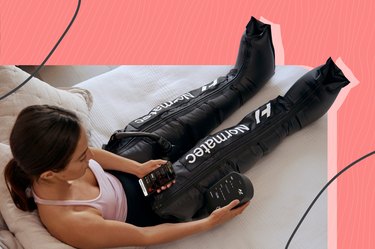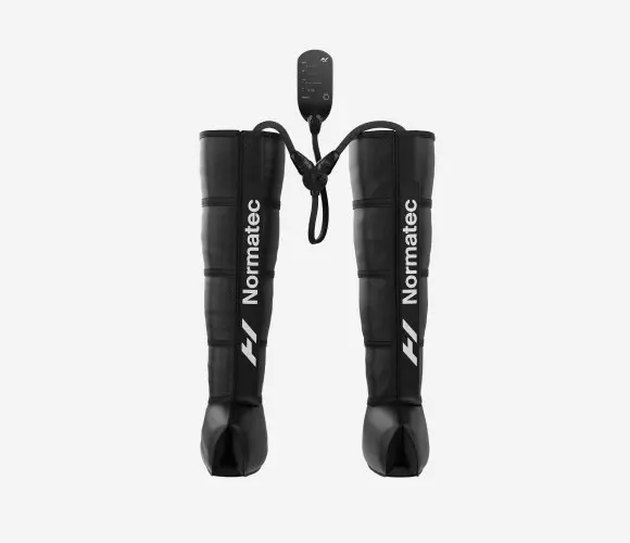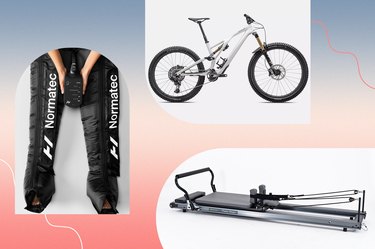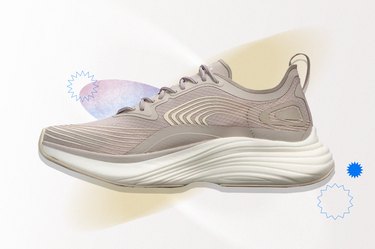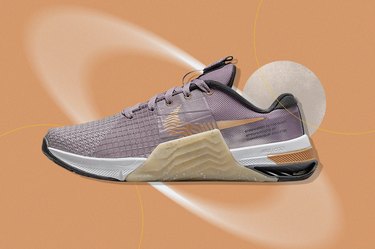Post-workout recovery is important: It can increase blood flow to support muscle recovery, help your body process lactic acid and prevent injury. So it's no wonder that after years of skipping cooldowns and post-run stretches, I developed some stubborn shin splints.
And let's face it, I'm lazy. My foam roller, despite it's potential to soothe my shin pain and prevent or ease aches in other muscles, is still collecting dust in a corner.
Video of the Day
Video of the Day
Enter Normatec boots — the Normatec 3 compression therapy boots, to be exact. LIVESTRONG.com Health Writer Ciara Lucas, CPT and RRCA-certified run coach, has a pair and loves them.
"I decided to invest in these compression boots after running my first marathon," she says. "Recovery is key especially during marathon training and I felt it was time build my recovery routine. These compression boots prevent my muscles from being sore and help me bounce back a lot faster than before using them."
I decided to give them a try and discovered they're a great way to recover after a workout, ease tight muscles from shin splints and prevent further damage without having to lift a finger.
Here's why the Normatec compression boots were a game-changer for my recovery routine, plus whether or not you should try them yourself.
First, What's Compression Therapy?
There are all sorts of compression therapy tools, including compression socks, bandages and sleeves. The common denominator? These products aim to increase blood flow, according to November 2012 research in the Annals of Vascular Diseases.
Compression boots like the Normatec 3 are a particular type of therapy called intermittent pneumatic compression (IPC). IPC sleeves sequentially inflate and deflate to squeeze your legs (or other body parts), resulting in a sort of massage that encourages circulation, according to the Cleveland Clinic.
In some cases, compression therapy is used to improve blood flow for people with chronic conditions like venous and lymphatic disease. Similarly, IPC devices are often used to prevent deep vein thrombosis in people who are inactive while recovering from illness or surgery, per the Cleveland Clinic.
These devices have also come to the mainstream as a potential tool to support athletic recuperation by increasing blood flow to tired, post-workout legs, thereby speeding up the muscle recovery process.
And, there's some evidence to back up these claims. For instance, a small June 2017 study in PLOS One found that using an IPC device after resistance training helped preserve flexibility and reduce oxidative stress on the muscles of 20 people.
However, this study was small, so more research is needed to better establish this link.
A January 2021 review in the Journal of Sport Rehabilitation found that IPC helped provide short-term relief from delayed-onset muscle soreness after endurance training. The researchers also noted, however, that these devices didn't have a lasting effect on exercise-induced muscle damage.
The takeaway: Compression therapy is most effective at preventing or managing underlying blood flow or clotting conditions. That said, there's little risk to trying one for athletic purposes — while it isn't a cure-all for your post-workout woes, it can definitely feel good and may help support muscle recovery.
How the Normatec Boots Work
The Normatec 3 are the most intuitive boots the brand has launched yet: Just slide on the sleeves, plug the boots' hoses into the small control unit, select your desired pressure and treatment time and let the device do its thing.
The boots offer seven levels of intensity, delivered to your legs via Normatec's patented Pulse technology, which pumps air into five overlapping zones so all of your muscles get adequate compression.
There's also Bluetooth connectivity to link your Normatec boots to the Hyperice app, allowing you to easily control the device from your phone.
What a Recovery Session Is Like
Before even trying the device, I was shocked by how compact the Normatec recovery boots are. The sleeves fold down to a portable size, and the face of the three-pound control unit is around the size of a Kindle.
Setup was a breeze — after charging the control unit, I plopped down on the couch, slid on the sleeves, plugged them in and pressed play (on both the Normatec device and Netflix).
I started with a 30-minute session with level four intensity. In short, it felt amazing. The boots squeezed my legs from the bottom up: The pressure was enough to feel like my muscles were massaged, but not so intense that I felt pinched or suffocated.
The coverage of the compression was also perfect — every inch of my legs felt hugged as the boots inflated, not just the wider areas like my calves or upper thighs.
"I like how you can control the intensity of the compression, on a scale of one to seven," Lucas says. "I usually use them at full intensity and after an hour my legs feel fresh again."
Before I tell you how the Normatec books affected my shin splints, some context: My shin splints come from a combo of overtraining, under-stretching and old running shoes. Besides my shins, the bulk of the discomfort occurs in my lower hamstrings. They feel tight, stiff and sensitive, which is why my main goal with Normatec compression was to relieve hamstring irritation.
To do so, I settled in for a half-hour compression session after every workout (and often again at night while lounging on the couch, just for a bedtime massage) for a week. I found the boots temporarily relaxed my stiff hamstrings after a workout. The repetitive massaging sensation helped the muscles feel warm and loose, when ordinarily they tighten up as soon as I stop exercising.
Even better, having an easy and reliable recovery technique to look forward to sneakily forced me into (finally) maintaining a cooldown routine. Before, I would finish my workout, shower and go about my day. Now, though, I look forward to my post-training massage, which motivates me to make the extra time to sit down, stretch, hydrate and take care of myself after activity.
And it's this consistent, well-rounded routine — of which Normatec boots are a part — that has really jumpstarted my shin splint recovery.
As an added bonus, these compression boots have benefited my mental health. Though I didn't expect it, getting cozy on the couch for a leg massage helps me unwind and relax physically and mentally at the end of the day. These boots are billed as an athletic recovery tool, so I didn't anticipate this perk — but hey, I'll take it.
Try Them Yourself
Clocking in at $699 a pair, these are no small purchase — though this is a relatively affordable option for professional-grade compression sleeves, which typically run upward of $1,000 a pair.
My verdict is that they're worth it, and you don't have to take it from me: "I definitely consider these compression boots worth the price," Lucas says. "Once you start using them and experiencing the benefits, the return on investment is almost immediate."
More Gear We Love
- Annals of Vascular Diseases: "Compression Therapy: Clinical and Experimental Evidence"
- Cleveland Clinic: "Intermittent Pneumatic Compression (IPC) Device"
- Journal of Sport Rehabilitation: "The Effects of Intermittent Pneumatic Compression on the Reduction of Exercise-Induced Muscle Damage in Endurance Athletes: A Critically Appraised Topic"
- PLOS One: "Does external pneumatic compression treatment between bouts of overreaching resistance training sessions exert differential effects on molecular signaling and performance-related variables compared to passive recovery? An exploratory study"
Was this article helpful?
150 Characters Max
0/150
Thank you for sharing!
Thank you for your feedback!
